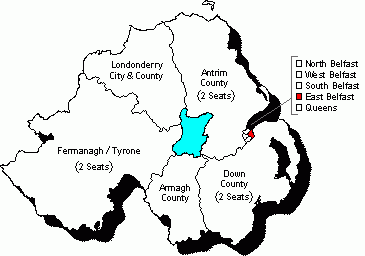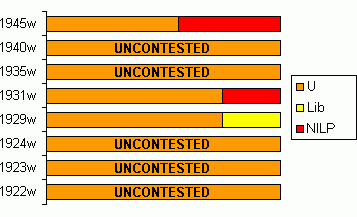

 |

|
| |
| |

|

|

|
| Map and diagram by Conal Kelly | ||
Incorporating the eastern quarter of the city of Belfast, this constituency was established under the terms of the Government of Ireland Act 1920. The original East Belfast constituency had been eliminated as a result of the 1917 Redistribution of Seats (Ireland) Act. This new constituency replaced the short-lived Westminster seats of Pottinger and Victoria. Between 1922 and 1949 the constituency was represented by three different MPs, all of whom were Unionist. The longest serving of these was Herbert Dixon, who was first elected in 1918 (Pottinger) and continued to represent the constituency until his elevation to the House of Lords (Lord Glentoran) in 1940. The general elections of 1922, 1923, 1924 and 1935 and the by-election of 1940 went uncontested. The declared winner in each case was the sole Unionist nominee. The constituency had the lowest turn-out across Northern Ireland in the 1931 general election.
See also election results for East Belfast 1950-1970, 1973-1982, 1983-1992 and 1993-2007.
| U | Lib | NILP | |
| 1945w | 56.4% | 43.6% | |
| 1940w-b | * | ||
| 1935w | * | ||
| 1931w | 75.1% | 24.9% | |
| 1929w | 75.1% | 24.9% | |
| 1924w | * | ||
| 1923w | * | ||
| 1922w | * |
* The only candidate nominated for the 1922, 1923, 1924 and 1935 General Elections was Unionist Capt. Herbert Dixon. The only candidate nominated for the 1940 By-Election was Unionist Henry Harland. In each instance the sole candidate was therefore duly elected without a contest.
Unionist majority: 4,869; electorate: 60,175; votes cast: 63.2%
Following the
retirement of Henry Harland, the Unionist Party selected Thomas Cole
to defend their seat. The NILP also challenged for the seat, putting
forward Tom Boyd as their candidate. In the closest result since
the seat was established, the Unionists were victorious but with a
much reduced majority of just under 5,000.
Cole had previously been elected to Lurgan Urban District Council
between 1911 and 1917. He was also elected to Belfast Corporation
between 1931 and 1958. He stood unsuccessfully for the Northern
Ireland House of Commons in Belfast Pottinger in 1933 and 1938 and
successfully in Belfast Dock in 1949. Boyd also stood unsuccessfully
in Belfast Victoria in 1938, Belfast Bloomfield in 1949, and Pottinger
in 1953. In 1958, he finally won a seat in Pottinger and also became
leader of the NILP.
Unopposed Unionist Candidate.
Following the
elevation of the incumbent, Dixon, to the House of Lords, a by-election
was required. Henry Harland was selected as the Unionist Party candidate.
As so often was the case in East Belfast, there was no other
nominee and Harland was duly elected unopposed.
Henry Harland was a Director in the Harland and Wolff shipbuilding firm and
nephew of its founder and former MP for North Belfast, Sir Edward Harland.
Unopposed Unionist Candidate.
In this, his
final outing in East Belfast, Dixon once again had the luxury of not
having any opposition. He was duly elected without a contest for the
fourth time since 1922.
Dixon had been re-elected to the Northern Ireland Parliament for the
Belfast Bloomfield constituency in 1933. He would continue to represent
that constituency until his death in 1950. He became 1st Baron Glentoran
of Ballyalloly in the County of Down in 1939 and was appointed Minister
of Agriculture in 1940.
Unionist majority: 19,021; electorate: 57,166; votes cast: 66.2%
As was the case in 1929,
Dixon once again faced a challenge for his seat. This time round his opponent
was Northern Ireland Labour Party (NILP) candidate John Campbell. The change in
opposition, however, made no differnece to the outcome, with Dixon garnering
over 75% of the vote and increasing his majority to 19,000. At 66.2%, East
Belfast had the lowest turn-out of the three contested constituenies across
Northern Ireland in the 1931 general election.
John Campbell was elected to represent the Dock ward on Belfast Corporation.
Unionist majority: 18,625; electorate: 56,426; votes cast: 65.7%
Despite having successfully
stood in three previous elections for East Belfast, Dixon had the novel experience
in 1929 of actually facing opposition. His opponent came in the guise of Liberal
candidate, Capt. Denis Ireland. In the end, the result was a comfortable victory
for Dixon with a massive majority of over 18,000.
Earlier in the month, Dixon had been re-elected to the Northern Ireland Parliament
for the new single seat Belfast Bloomfield constituency. Denis Ireland was appointed
to Irish Senate in 1948 by Taoiseach John Costello. He was the first member of the
Oireachtas to be resident in Northern Ireland.
Unopposed Unionist Candidate.
In the third election in as many years, Dixon was once gain the sole candidate nominated in East Belfast and was once again duly elected without a contest. East Belfast was one of only three seats that went uncontested in the 1924 general election.
Unopposed Unionist Candidate.
As was the case
in 1922, Dixon was the sole candidate nominated in East Belfast and
was duly elected without a contest once more. East Belfast was one of
nine seats that went uncontested in the 1923 general election in Northern
Ireland. The sole nominee (and hence winner) in each instance was the
Unionist candidate.
Dixon was appointed to the Privy Council of Northern Ireland in 1923.
Unopposed Unionist Candidate.
This was the
first election for the newly established East Belfast constituency.
The new constituency replaced the Belfast Pottinger and Belfast Victoria
constituencies that had been used in the 1918 election. Capt. Herbert
Dixon had been previously elected to represent Pottinger in 1918 and as the
sole nominee he was duly elected without a contest for East Belfast.
Dixon had also been elected to the Northern Ireland House of Commons
in 1921 as a member for East Belfast (4 seats). He was appointed
Government Chief Whip and Parliamentary Secretary to the Ministry of Finance.
See also:
Results from 1922 to 1949 for each seat: East Belfast | North Belfast | South Belfast | West Belfast | Antrim | Armagh | Down | Fermanagh and Tyrone | Londonderry | Queens University
Other sites based at ARK: ORB (Online Research Bank) | CAIN (Conflict Archive on the INternet) | Northern Ireland Life and Times Survey
Your comments, please! Send an email to me at nicholas.whyte@gmail.com.
Conal Kelly, 10 October 2007.
|
Disclaimer:©
Nicholas Whyte 1998-2004 Last Updated on Wednesday, 12-Jan-2005 12:12
|